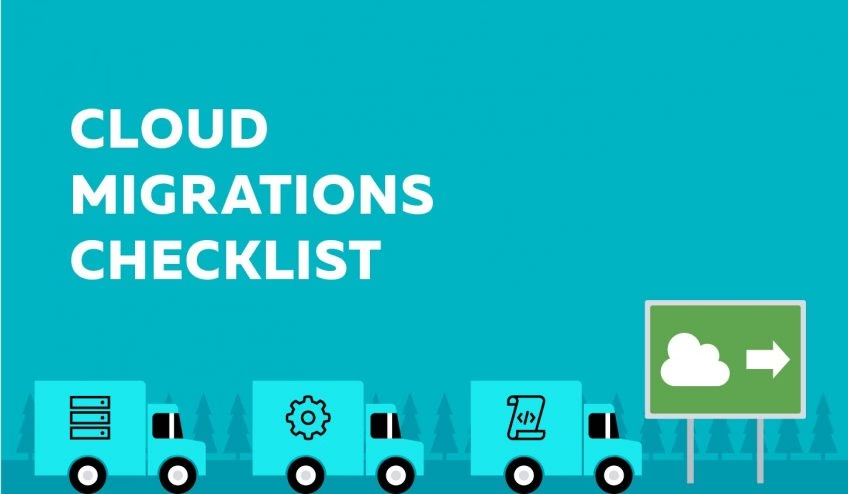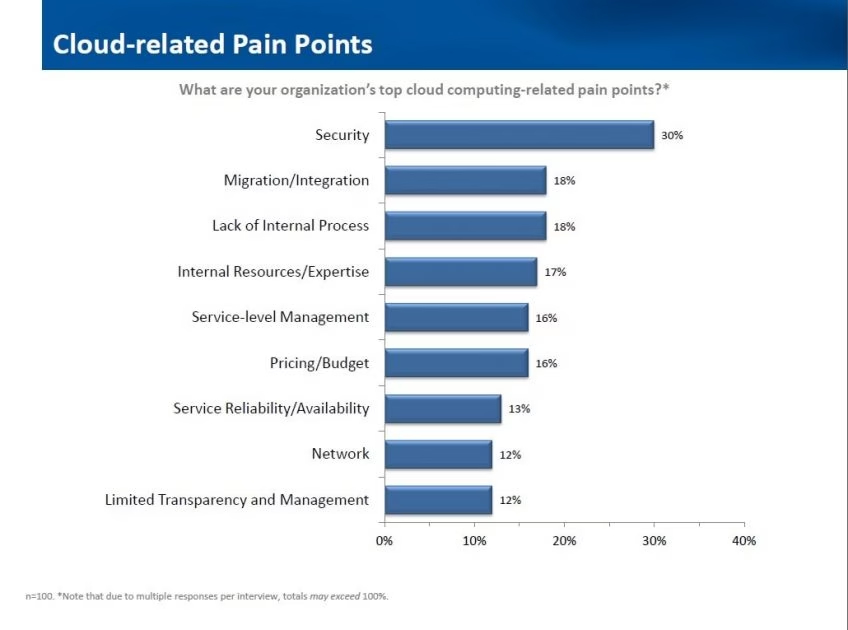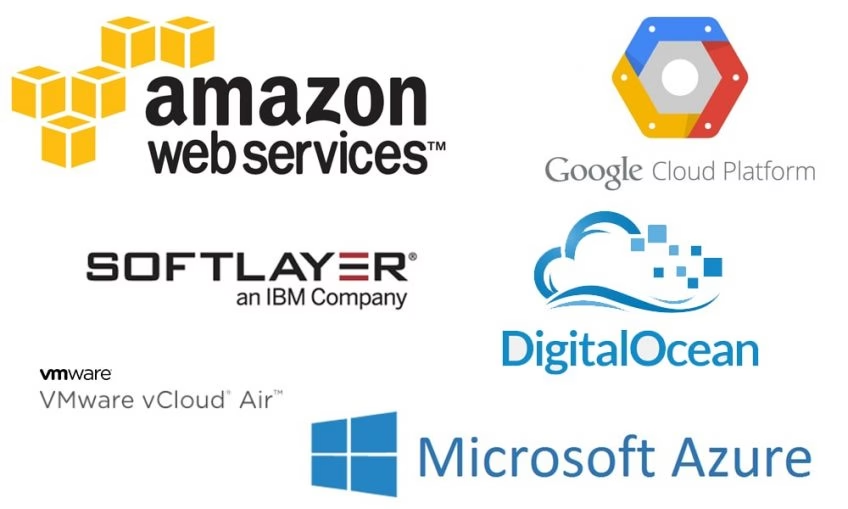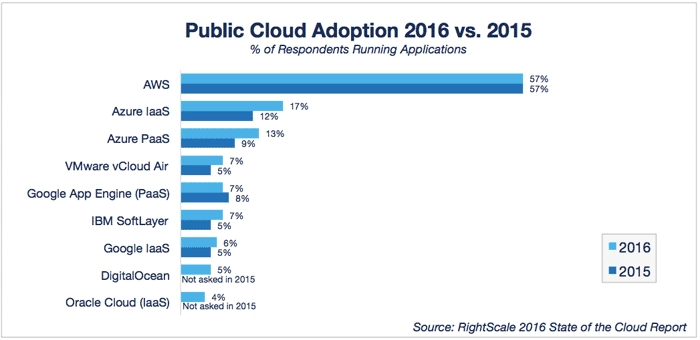
How to Organize a Cloud Migration Checklist?
Want a great cloud migration checklist? Look no further as we have prepared a step-by-step guide for you here.
On a list of the most common cloud-related pain points, cloud migration comes right after security.

In reality, these points are all related to each other. By having a solid cloud migration plan and great execution, most of these common problems will be solved before they have the chance to cause you any pain.
To make sure things go well for you, I've made this cloud migration checklist to help you avoid common mistakes.
Cloud Migration Checklist
This checklist for successful cloud migration strategy can be broken down into four main parts:
- Choosing the right cloud provider
- Preparing and planning
- Migrating to the cloud — applications and data
- Checking and validation
If you follow each of these steps, it should be a fairly smooth process. Each stage has its own questions to ask and steps to follow. Let's take a look at each section in more detail.

Get a complimentary discovery call and a free ballpark estimate for your project
Trusted by 100x of startups and companies like
1. Choosing the Right Cloud Provider

There are so many options when looking for cloud services. Selecting the right one for your business depends on MANY factors. If you've got a specific cloud provider in mind, ask yourself the following questions to make sure they really are the best option.
What are the popular options?
Amazon Web Services are still the most popular cloud service option. They were the first to make cloud computing a commodity, and they are still an excellent option. You can use this guide for any of the providers, e.g. as an AWS migration checklist.
After that are the biggest IT companies such as Microsoft Azure, Google Cloud, IBM, etc. These major cloud providers are catching up to Amazon, and offer different features and pricing structures.

What matters most to you?
Each provider has a specific set of strengths and weaknesses. Some offer enormous scalability in seconds, while others offer more personalized application management options.
Don't just select the market leader, actually go through what the provider focuses on, and judge whether that makes sense to your business.
Database size / capacity demands
Knowing these will help you know if a provider can actually deliver the level of service you need. The last thing you want to do is spend time and effort migrating to one provider, then have to move to another to scale up again.
How much will it actually cost?
Calculating cloud computing costs can be complicated. It's never going to be as simple as the figures on the pricing page make out. Make sure you look into detail about exactly how your applications will operate in the cloud environment.
Look for hidden charges based on things like messages sent, bandwidth, API calls, and even geographical location.
Model some real-life scenarios to calculate the actual costs of each cloud provider you are considering.
2. Preparing to Migrate
Once you've chosen a cloud provider, it's time to start preparing. Proper planning is the most important stage of the process. If you do it well, the following steps should be a breeze.
What to move first?
The first applications you move to the cloud should be the easiest. Prioritize migration components that are the least critical. This way you can get a feel for the process, and deal with unforeseeable problems while the stakes are still low. Choose the data and applications that are most suitable for a cloud environment, and migrate those first.
Will your application architecture need to change?
Cloud server migration involves computing environments that run differently than your current system. Servers, networks, and data services all run and interact differently, and you need to make sure you update parts of your system to be ready for this change.
How will the move affect performance?
Performance is probably one of the key reasons you chose to migrate. But applications won't always run faster or even as fast in a cloud environment.
Hire expert developers for your next project
1,200 top developers
us since 2016
Unexpected bottlenecks can occur when changing to distributed environments. Sure you'll have access to lots of storage and cloud resources, but communication overhead might be higher than you thought.
Is your staff ready?
Your staff will need to know all of the new technologies and processes. You'll need to have your developers, managers, and administrators all ready for the change ahead of time.
How will you operate the new service in the cloud?
Migrating a database or application to a new environment is just the start. How do things run from there?
Your application migration to the cloud checklist should include
- updating code
- troubleshooting problems
- measuring performance
Dealing with downtime
Can your users deal with a bit of downtime while you migrate? If not, you will need a strategy in place that allows you to make this transition more smooth.
Governance and security changes
Many of your business processes might not apply to cloud applications. You'll have less control over security and other procedures, and things will need to work with your cloud provider's offerings.
Security is one of the main deterrents to moving to the cloud. Applications can be extremely secure, but you won't own any of the hardware, for instance, a data center. This means dealing with threats and breaches will be very different than before.
To keep your data secured after data migration, you'll need to re-evaluate your security procedures and strategies.
3. Migrating
If you spent enough time in the planning phase, the actual migration should go smoothly. Of course, there will be unexpected problems, but these will be minimized. You'll need to use the tools you've decided on correctly.
How are you moving data?
Depending on the size of your databases and applications, you will use different techniques for actually copying everything over.
If you don't have too much to migrate, you can just copy the data over your internet connection.
This approach isn't ideal for larger workloads. You might have very long transfer times or charges from the cloud providers. To deal with this, you could compress the data before sending it. Alternatively, you could ship your physical drives to the provider to reduce bandwidth costs.
Security during migration
If security is important while on the cloud, it should be just as important when sending all that information and code to the cloud. Any temporary storage locations used along the way for sensitive data should be just as secure as your end destination.
Migrating your data
Moving a database can be tricky. Use the right tools for the job, and make sure the new structure and limitations of your database will work correctly.
Use the right migration tools
Hire expert developers for your next project
Whatever tools your provider has given, make sure you really know how they work. Moving databases can be tricky, even with great tools. Your best bet is to consult an expert that used them before.
Make sure it's portable
You'll want to make sure once you move your application, it doesn't get 'locked in' to one cloud provider.
The main obstacle to this is metadata. Tools like virtual machines seem like they could move easily between cloud environments. However, metadata is usually specific to a cloud platform. Understand how you can keep track of this and keep your application portable.
4. Checking Everything Went Well
This is the last step in this cloud migration checklist. After you've migrated your data and applications to the cloud infrastructure, you'll need to make sure everything is working. This might not be as simple as you think.
Ideally, you'll want to have an automated testing strategy. This will check important things like
- Did it work?
- Did all of the data make it?
- Is it all reachable to users?
- Are all of the internal components communicating properly?
- Can all of your admin tools monitor the new cloud app properly?
If you can't set up an automated test like this, you'll want to do a thorough manual one.
Find a Great Team to Help You with Cloud Migration

Actually executing all of the steps on this cloud assessment checklist successfully is difficult. Your best bet is to work with a migration team that has done this before, many times.
Any sort of IT migration is dangerous and error-prone. Experience is necessary to foresee and avoid problems and additional cloud costs. You might think you can do it on the cheap yourself, but it will almost certainly cost you more money in the long run. A great cloud migration services provider is essential.
Moving to the cloud is a way to get a better and faster service for cheaper. This is only possible if you follow all the steps correctly.
More Info on Cloud Migration Checklist
If you are looking to get started, take a look at the top 10 internet-of-things cloud platforms. Or, if you need more convincing to move your application over to the cloud, have a look at our top 10 benefits of cloud computing for a business article.
Key Takeaways
Cloud migration is a complex endeavor. It's safe to have a cloud migration checklist not to miss anything important during the process. Here's a cloud migration checklist we've compiled for you:
- Choose the right cloud provider
- Explore popular options
- Pay attention to your database size and capacity demands
- Calculate cloud computing costs
- Prepare to migrate to the cloud
- Prioritize migration components
- Change your app architecture if needed
- Determine if the migration will affect app performance
- Prepare your staff
- Update the code, troubleshoot the problems, and measure performance
- Develop a strategy to deal with downtime
- Rethink your governance and security procedures, if needed
- Move your apps and data to the cloud
- Select a cloud migration technique
- Ensure the cloud migration process is secure
- Choose cloud migration tools wisely
- Keep your application portable
- Check and validate
- Conduct an automated test
- Conduct a manual test if an automated test cannot be set up
Planning for Cloud Migration?
So you've decided you want to move your services to the cloud. Congratulations! That's a great decision that will help take you and your business and applications to the next level for so many reasons, as we outlined in our article.
However, the cloud migration process can be painful without proper planning, execution, and testing. A survey found that only 27% of respondents were extremely satisfied with their overall cloud migration experience.
As we mentioned earlier, you can make the cloud migration journey smooth for your business by partnering with experienced cloud-computing engineers. If you are still looking for such cloud developers, DevTeam.Space can help you.
Get in touch via this quick form describing your initial cloud adoption requirements and one of our technical managers will get back to you to discuss more details on your cloud migration project team, planning, management, etc.
Frequently Asked Questions on Cloud Migration Checklist
It is a checklist that helps ensure that all the steps required to move business processes over to the cloud have been done.
More and more businesses are moving their business systems over to the cloud as the benefits become apparent. Today, there are cloud software solutions for just about every business process.
Right here. Read our cloud migration checklist in this article and copy what you need.



